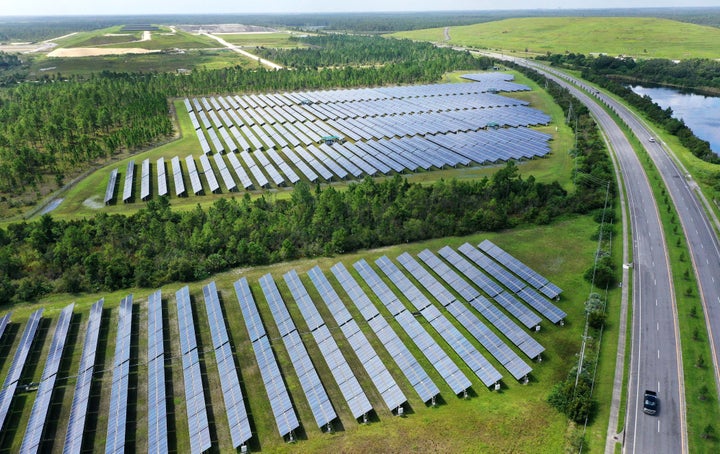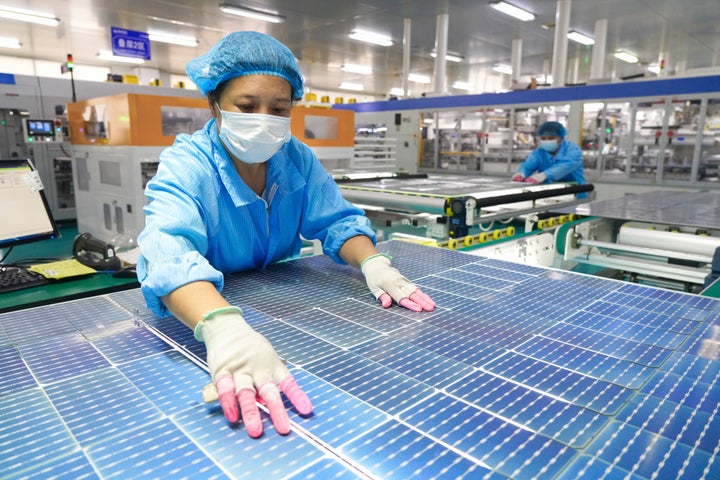
The United States invented the modern solar panel in 1954. A quarter century later, American companies dominated 95% of the global solar market.
The collapse took only a few years. By the mid-1980s, with Japanese rivals racing ahead, the U.S. share of the market shrank to 55% and declined steadily from there as Chinese and South Korean firms ascended.
Sen. Jon Ossoff (D-Ga.) wants to reverse that course.
The senator’s bill to boost domestic manufacturing of solar panels made it into Democrats’ sweeping infrastructure package, the Build Back Better Act. If passed, the legislation would provide tax credits to factories that produce the components for photovoltaic panels, laying the groundwork for a new domestic supply chain that would make the country less dependent on China for the U.S.’s fastest-growing source of electricity.
It’s a novel approach, analysts say ― one that could avoid mistakes previous federal policies made when trying to bring clean-energy manufacturing home. But it also depends on trade policies that artificially inflate the price of imported goods and threaten to slow the speed at which solar energy grows while prioritizing a segment of the industry that employs fewer workers.
“As we accelerate the transition to renewable energy, we can’t rely upon imports, particularly from countries with whom we may not have stable trading relationships,” Ossoff told HuffPost in a phone interview this week. “My legislation would spark a global realignment of solar supply chains by bringing every step of that supply chain ― from polysilicon to ingots and wafers to modules ― to the U.S.”
On Friday, the senator is scheduled to fly to Glasgow, Scotland, to attend the United Nations’ climate summit. From there, he’s scheduled to travel to South Korea, where he plans to meet with high-ranking government and corporate officials in a bid to encourage more manufacturers to open factories in the U.S.
The few remaining solar manufacturers in the U.S. have benefited from tariffs the Trump administration put in place in 2018. Starting at 30% and dropping 5% each year, the import duties were meant to make panels built in the U.S. with this country’s higher labor and material costs competitive with the much cheaper hardware that China produces.
In response, the U.S. division of South Korean solar giant Hanwha Q Cells opened the Western Hemisphere’s largest panel assembly plant in Dalton, Georgia, in September 2019. Georgia is also home to one of the country’s largest electric-vehicle battery factories, owned by SK Innovation, another South Korean behemoth.
“My vision is that the U.S. should lead the world in renewable energy technology, innovation and manufacturing, and that Georgia should lead the nation,” Ossoff said.
Ossoff’s bill would expand the domestic supply chain by giving tax credits to companies that manufacture the photovoltaic cells ― the individual sunlight-absorbing black or gray strips on a solar panel ― 4 cents per watt of electricity, an industry measurement calculated by totaling the cost of the equipment and dividing it by its electricity-generating capacity.
Firms that then assemble their own U.S.-made cells into modules ― the pieces that, when put together in an array, make up a full panel ― would receive 11 cents per watt. Manufacturers that assemble imported cells into modules would get 7 cents.
The average cost of a U.S.-made module comes out to about 33 cents per watt, so the tax credits would cover up to a third of the manufacturing expenses for a firm making its own cells.

But the most generous tax credits in the bill would go to making wafers, the thin slices of crystalline silicon that power each cell and of which there is virtually no production in the U.S. The legislation provides 5.5 cents per watt on an item that costs on average 8 cents to make, covering roughly two-thirds of the manufacturing expense.
Trying Something New
Past attempts to bring clean-energy manufacturing back from low-cost, minimally regulated developing countries in East Asia to Western nations with strict labor and environmental rules have largely fizzled. A lengthy essay in the London Review of Books this summer chronicled the rise and fall of a Korean-owned wind turbine factory in Scotland and concluded that production seemed destined to return to the cut-rate assembly plants in Vietnam once the European country’s incentives ran out.
Solar manufacturing is far more automated than wind turbine factories, so the higher labor costs and different working patterns are a lesser concern for East Asian companies setting up shop in North America or Europe. But Ossoff’s bill also proposed a novel approach to getting manufacturers to not only open factories but also keep them running.
Unlike the tax credits the Obama administration enacted more than a decade ago, which paid companies based on just building factories, the incentives in Ossoff’s legislation kick in only when firms actually produce things. This means the manufacturers will need to find buyers and integrate into the supply chain, increasing the chances that the business lasts.
“The Obama-era manufacturing incentives encouraged companies to build a big factory, cash in on the incentive, but there was no incentive to stay in the country after they cashed out,” said Pol Lezcano, a solar analyst at the energy research firm BloombergNEF. “The structure Ossoff proposes is incentivizing the factory to actually be productive and continue to be relevant into the future, meaning you’re not getting everything upfront in the first 12 months once you commission the factory.”
He said it was “the first time we’ve seen an incentive structured this way.” The model hews closer to how developing countries attract foreign companies to set up local shops. India, for example, pays manufacturers per unit of output they produce. China offers government-backed financing and low interest rates for local factories. And Brazil provides solar companies with cheap loans through the Brazilian Development Bank but only if the firms use locally made panels and components.
Competing Priorities
Still, according to BloombergNEF, the tax credits make U.S. manufacturing truly competitive with Chinese factories only if tariffs remain in place on East Asian imports. The U.S. solar industry, which primarily employs Americans selling and installing panels, complained that the duties killed jobs in a business that, in 2016, took on one in every 50 new hires. But President Joe Biden rebuffed the industry’s requests to end the tariffs.
Now the U.S. International Trade Commission is considering whether to extend the tariffs, and the Commerce Department is weighing a separate request from an anonymous petitioner to slap new import duties on panels from Southeast Asia.

The companies that requested the tariffs the Trump administration granted said the import duties would create 45,000 jobs in solar manufacturing. But solar factory jobs actually declined by 9% last year alone, according to the most recent job census from the industry-backed Solar Foundation.
The Solar Energy Industries Association, the sector’s most powerful national trade group, urged the Biden administration to end the tariffs and reject the request for new ones.
“The bottom line is that the climate can’t afford these tariffs,” Abigail Ross Hopper, the trade association’s president, said in a statement. “Commerce should reject these baseless petitions now because the climate, the economy and thousands of American jobs are on the line.”
Ossoff declined to comment on the tariffs, stating that he was “still reviewing the trade policy debate.”
“My focus at this time is on enacting legislation that will allow us to rapidly scale a fully integrated domestic supply chain,” he said.
Doing so, said Lezcano, may be at odds with rapidly creating jobs and deploying solar energy.
“You just have very different priorities, and those priorities are not necessarily complementary to each other,” Lezcano said. “If your goal is geopolitics and domestic supply-chain security, onshoring is a solution for that. If your objective is purely economics and rapid adoption, then the right way to go is to remove all the tariffs and get the cheapest modules.”
Ossoff said the politics of domestic manufacturing matter. Democrats’ losses in this week’s state elections are widely seen as a harbinger of a Republican wave in the 2022 midterm election that could give the GOP control of Congress and make it harder for the Biden administration to pass legislation. Yet, Ossoff said he was “already working with Republican officials at the state and local level to build Georgia as a national leader in renewable energy.”
“We have a clear and compelling national interest in building our industrial base, manufacturing capacity and technological innovation, in developing more energy independence and national security interest in not being reliant upon certain foreign markets for some of these components and technologies,” Ossoff said. “It’s a unifying issue, and it should be a unifying issue.”

